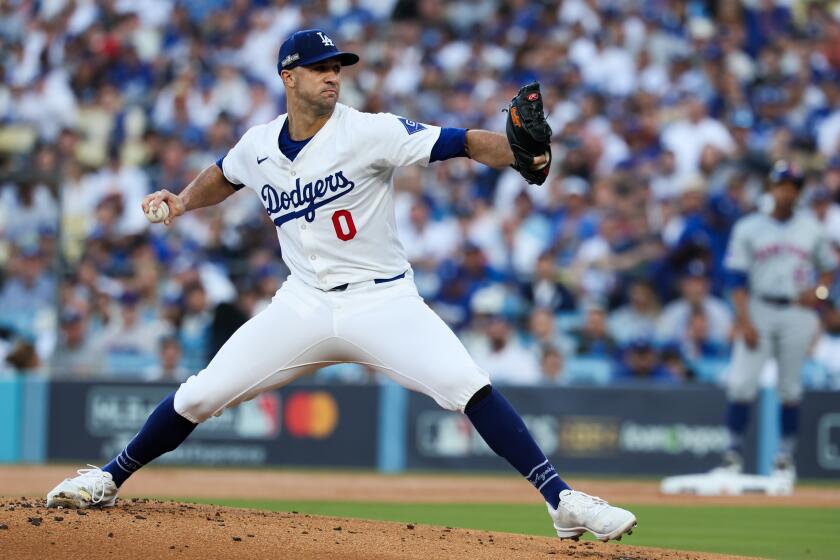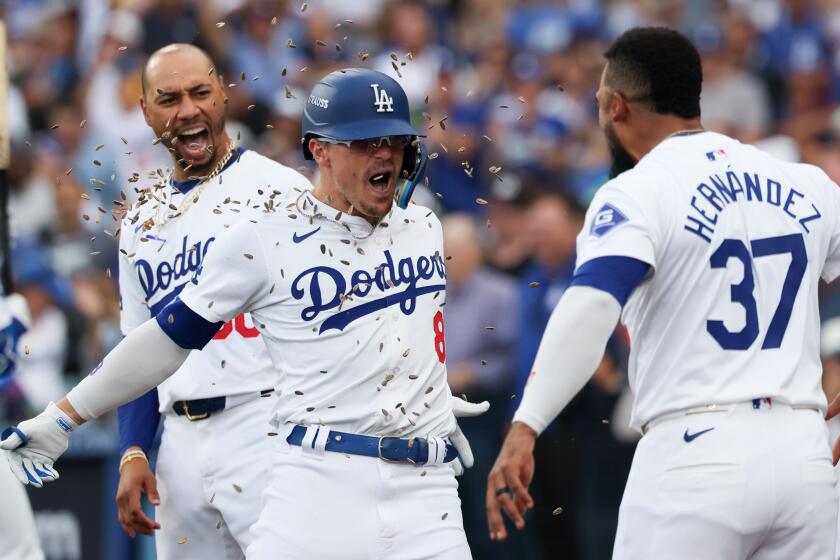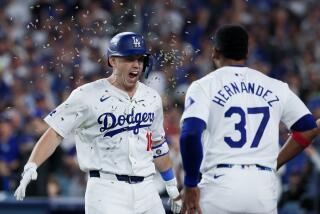
- Share via
The Dodgers had been here before.
Coming off an emotional five-game division series against a National League West rival. Entering an NL Championship Series against a team with whom they were much less familiar. Four wins from reaching the World Series, and considered safe favorites to get there. But needing to regroup, and make a 48-hour shift from one series to the next.
In 2021, the Dodgers couldn’t do it. After defeating the San Francisco Giants in Game 5 of the NLDS, they lost Game 1 of the NLCS to the Atlanta Braves two days later. They never recovered. Their October ended early.
“We beat a really good team then and then played another really good team and lost, thinking that we could reset and get back into the flow,” recalled outfielder Mookie Betts, one of several holdovers from that 2021 team. “It doesn’t really work like that. I think it was a great learning experience for all of us.”
Three years later, they got to apply that knowledge this week.
On Friday, the Dodgers experienced the high point of their season so far, knocking out the San Diego Padres in a winner-take-all game at Dodger Stadium.
The Dodgers’ injury-riddled pitching staff is refuting history and their reputation by shutting out playoff opponents for a record-tying 33 innings.
Then on Sunday, they were right back at it against the New York Mets, in a set of circumstances eerily familiar to that 2021 campaign.
This time, however, the two-day turnaround went smoother than before. In Game 1 of the NLCS, the Dodgers delivered a 9-0 thumping to keep the momentum rolling.
“I think we just stayed on that high,” Betts said. “We didn’t try and reset.”
Instead, the offense jumped on Mets starter Kodai Senga early, tagging him with three runs in less than two innings before adding three more in the fourth.
Jack Flaherty pitched seven dominant innings, extending the team’s scoreless inning streak to a whopping 33 innings — tying a Major League Baseball postseason record — while also producing the longest shutout start in a playoff game for the Dodgers since Clayton Kershaw in 2020.
If that wasn’t enough, the Dodgers’ defense was brilliant, too, making leaping catches at the wall, extending for snags over the foul-ground barrier and even throwing out a baserunner on a clueless fifth-inning mistake from Mets designated hitter Jesse Winker.

When the game was finally over, much of the 53,503-person crowd had already filed out.
By then, a resounding Game 1 statement had been long ago delivered.
“The most important part,” Flaherty said, “was coming out and setting a tone.”
Sunday wasn’t supposed to be this easy for the Dodgers, not after all their advance work was crammed into a 48-hour window.
Unlike prepping for the Padres, a team the Dodgers had seen 13 times this year, including the penultimate series of the regular season, their last meeting with the Mets was in late May.
At that time, the Mets were 11 games under .500, seemingly headed toward a fire sale at the trade deadline, and spiraling so bad that when one of its relievers reportedly said he played for the “worst team” (the reliever, Jorge López, later claimed he was misquoted) it was nonetheless believable.

Since then, however, the Mets have played like a “completely different team,” manager Dave Roberts said.
Their 66 wins after May 29 — the final loss of a three-game sweep against the Dodgers — were the most in MLB. Their first two rounds of the postseason were defined by dramatic moments, including Pete Alonso’s go-ahead ninth-inning home run in the wild card series and Francisco Lindor’s NLDS-sealing grand slam a week later.
While the Dodgers went down to the wire with the Padres, the Mets enjoyed a few extra days of rest, as well, allowing them to line up their ace pitcher Senga to pitch in Sunday’s opener.
Yet, the Dodgers were ready.
The pitfalls of 2021 never reappeared.
Even with only one day to prepare, their coaching staff and scouting department worked through much of Friday night, all of Saturday’s off-day and into the wee hours of Sunday morning to get both the lineup and pitching staff up to speed.
Dodgers Max Muncy, Will Smith and Miguel Rojas helped develop play-led changes to their approach to the postseason, helping forge a unified mindset.
“You’re basically studying for a test,” said hitting coach Aaron Bates, who like most Dodgers staffers spent more time in meetings between the two series than he did sleeping.
“You sleep later,” Bates joked. “Just drink a lot of coffee, Ashoc [energy drinks], whatever you have to do to stay awake. And then, go off adrenaline.”
The Dodgers also had a plan against Senga, the Mets’ Japanese right-hander, knowing he would still be on a limited pitch count after making just one start in the regular season because of shoulder and calf injuries.
“A saying we’ve always kind of had when you’re approaching a guy that may not give a ton of innings, or maybe it’s an opener or any number of things is, he’s going to go as long as we let him go,” third baseman Max Muncy said.
With Senga lacking any semblance of command, the Dodgers didn’t let him get deep.

In the first inning, Betts walked on four pitches, Freddie Freeman took a free base from a full count and Teoscar Hernández watched four more balls miss the strike zone to load the bases.
An ensuing flyout from Will Smith offered only temporary reprieve.
After working a 2-and-1 count with two outs in the inning, Muncy dumped a down-the-middle cutter into center field for a single. Betts scored easily on the play. Then he turned and watched Freeman — with heavy spatting tape wrapped around his sprained right ankle — hobble across home plate. With Freeman unable to slow down quickly enough, Betts caught him in his arms, then wrapped him in a hug.
“I got Mookie to stop me from falling over at the end,” the 6-foot-5 Freeman joked.
“I’m only 170 pounds, and he’s a big dude, kind of collapsing,” added Betts, standing all of 5-9. “Luckily I lift weights, so I was able to hold him.”

After another walk in the second inning was followed by a sacrifice bunt and RBI single from Shohei Ohtani — who is six for eight this postseason with runners on base but hitless in 16 at-bats otherwise — Senga was finally chased from the game.
“I thought the hitting coaches did a great job of putting together a game plan,” Roberts said. “And then the players executed.”
The Dodgers kept building the lead in the fourth inning, when another successful sac bunt (it was their first game with two of them since September 2021) helped key a three-run rally.
The 6-0 lead was more than enough for Flaherty, who retired his first nine batters, held the Mets hitless through the first four innings and finished his 98-pitch gem with six strikeouts.
“It was just a pitching clinic,” Roberts said, especially pleased with how it afforded the club’s all-important bullpen some much-needed rest. “For us to get seven innings, in a long series, was huge.”
Flaherty briefly wobbled in the fifth, giving up back-to-back singles to lead off the inning. On the second one, however, Winker got thrown out on the bases as the lead runner, making a puzzling decision after being deked by Kiké Hernández in center field.

As Hernández fielded the bouncing ball, he lined his body up like he was throwing to third, but tricked Winker — who was between second and third — by firing for second instead. His head whipping back and forth in confusion over where the ball had gone, Winker slowed to a trot, allowing Gavin Lux to fire on to third where Muncy tagged him out.
It was that kind of game for the Dodgers, who piled on in the eighth on a three-run double from Betts.
“It’s all about playing our game,” Freeman said. “It’s about, keep applying pressure.”
Now, another quick turnaround in this series awaits them, with a matinee Game 2 scheduled for 1:08 p.m. Monday afternoon.
But in October, as the Dodgers coaching staff happily noted pregame, sleep can wait.
More to Read
Are you a true-blue fan?
Get our Dodgers Dugout newsletter for insights, news and much more.
You may occasionally receive promotional content from the Los Angeles Times.









